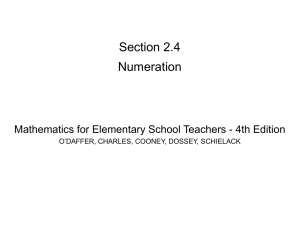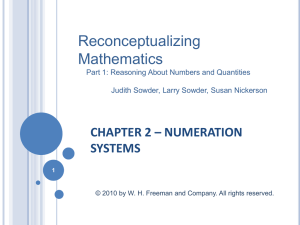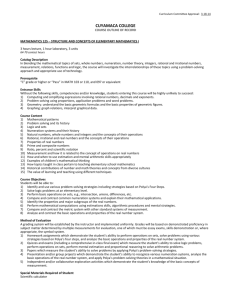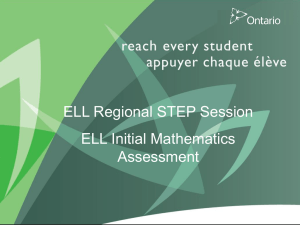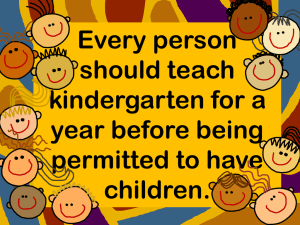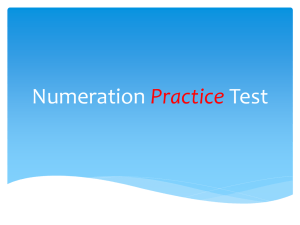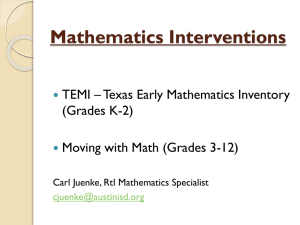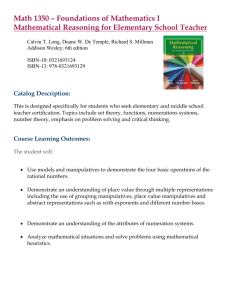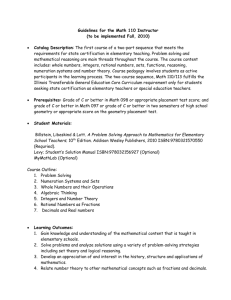this resource 332.32 KB
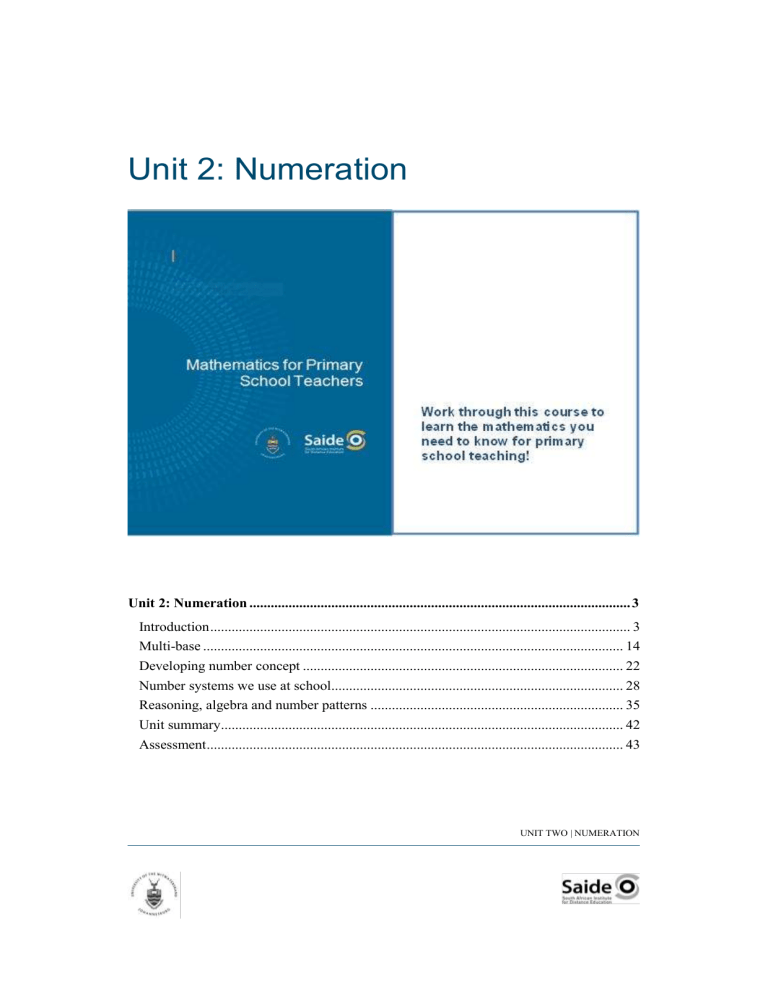
Unit 2: Numeration
UNIT TWO | NUMERATION
© Saide, with the Wits School of Education, University of the Witwatersrand
Permission is granted under a Creative Commons Attribution licence to replicate, copy, distribute, transmit, or adapt this work freely provided that attribution is provided as illustrated in the citation below. To view a copy of this licence visit http://creativecommons.org/licences/by/3.0/ or send a letter to
Creative Commons, 559 Nathan Abbott Way, Stanford,
California, 94305, USA.
Citation
Sapire, I. (2010). Mathematics for Primary School Teachers. Saide and the Wits School of
Education, University of the Witwatersrand, Johannesburg.
ISBN: 978-0-9869837-5-7
Saide
Fax: +27 11 4032813
E-mail: info@saide.org.za
Website: www.saide.org.za
P O Box 31822
Braamfontein
2017 Johannesburg
South Africa
MATHEMATICS FOR PRIMARY SCHOOL
Unit 2: Numeration
Introduction
A study of the development of numeration systems over time could be very interesting and revealing for our learners. It will give them insight into the development of the numbers that they see and use daily. They would realise that these numbers have not always existed, and they could also develop an appreciation of the beauty and efficiency of our numeration system in comparison to some of the older numeration systems which are no longer used . It could also draw on their own personal background (social and cultural) – we can look at systems of counting and recording used i n the not-so-distant past and even in the present by different cultural groups.
This unit is designed to give you some insight into a few specially chosen ancient numeration systems. As you work through the unit you should try to think about how the systems which are presented differ from each other, where they are similar to each other, and how they differ from, or remind you of our own numeration system that we use today . After the presentation of historic numeration systems, an in-depth study follows of the Hindu-Arabic numeration system, still in use today, with its base ten and place value.
Upon completion of this unit you will be able to:
Outcomes
Record numbers using some ancient numeration systems.
Explain the similarities and differences between the numeration system that we use and those used in ancient times.
Demonstrate the value of multi-base counting systems for teachers of the base ten numeration system in use today.
Discuss concept. the use of place value in the development of number
Develop your understanding of number systems that make up the real numbers.
Apply inductive reasoning to develop generalisations about number patterns and algebraic thinking.
History of numeration
In the very early days of cavemen, there is no evidence of the use of numeration systems, probably because such systems were not needed . Numeration systems developed because people began to feel the need to record the idea of "how many". What we are thinking of when we think "how many" is an idea of number . The symbols used to record "how many " are called numerals . A structured system for the use of these numerals is called a numeration system . People have used various numeration systems and symbols over time, but common to all of these systems is the idea of "how many", which is the abstract concept of number.
3
UNIT TWO | NUMERATION
How would you explain the difference between a number and a numeral?
Reflection
Tallying was one of the first commonly used methods of recording numbers.
When we tally we set up a one-to-one correspondence between the set of discrete objects that we wish to count (such as the number of cokes in the tuck-shop) and a set of easily stored tallies (such as dash marks on a piece of paper). Early tallies that were used were pebbles in furrows in the ground, knots in pieces of stri ng o r not c hes carved int o sticks .
When people began to settle in groups, numeration systems began , because the need arose to record numbers more formally, amongst other things.
Reflection
Would you describe tallying as a numeration system? Explain your answer.
Where do we still use tallying today and why do we use it?
Why do you think the need for more formal numeration systems arose when people began to live in communities?
MATHEMATICS FOR PRIMARY SCHOOL 5
Egyptian numeration system
The Egyp t ian numeration system consisted of certain hieroglyphic numerals and a system for the i r use. Hieroglyphics were commonly painted onto various surfaces, such as, for example, on the walls and pillars of temples . The symbols are given in the table below .
To write numbers, the symbols could be used in any order, as long as the necessary symbo l s were used to total up the number that the writer wished to record .
Thus the system could be described as repet i t i ve and additive , and it is not very compact.
A base of ten is evident in the choice of group i ng into consecutive symbols .
Egyptian
Numeral
Description Our numeral
Vertical line 1
Heelbone 10
Scroll 100
Lotus flower 1 000
Bent Finger 10 000
Barbot fish 100 000
Astonished man 1 000 000
Here are some conversions into Egyptian numerals and v i ce versa :
34 572 =
2 025 =
UNIT TWO | NUMERATION
Activity
Activity 2.1 a) What is meant if we say that the system is repetitive and additive? b) Why is the system not compact? Is our system more compact? c) In what way(s) does the Egyptian numeration system resemble our own numeration system? d) Try some conversions of your own, such as: a) 489 b) c) 1 000 209 = d) e)
MATHEMATICS FOR PRIMARY SCHOOL
Babylonian numeration system
The Babylonians used symbols known as cuneiform. In about 3000 BCE, clay was abundant in Mesopotamia where they were settled , and so they used clay tablets to make their records . The marks they made were wedge shaped, made in the clay with a stylus while the clay was still soft. They then baked the clay tablets in ovens or in the sun to preserve them. They had only two numerals initially, but introduced a third symbol to clarify some ambiguity that arose in the interpretation of numerals written with only the two symbols.
They used the following three symbols:
Babylonian Symbol Number Our numeral
One 1
Ten 10
Place marker 0
They did use place value, in a base of 60, which makes the i r system very difficult for us to read because it is so different from our own. Initially to indicate a new place or an empty place they just left a gap, but later they used their place holder symbol to indicate an empty place. We will look at numerals in the later Babylonian system.
Here are some conversions into Babylonian numerals:
23 = 56 =
63 = 679 =
7
UNIT TWO | NUMERATION
603 = 3 601 =
Activity 2.2
Activity
1.
Why do you think ambiguity arose when the Babylonians used only two symbols?
2.
Would you describe their system as repetitive and additive, and why?
3.
How does the Babylonian numeration system differ from the
Egyptian numeration system?
4. In what way(s) does the Babylonian numeration system r esemble our own numeration system?
MATHEMATICS FOR PRIMARY SCHOOL 9
C
D
M
X
L
I
V
Roman numeration system
The Roman numeration system developed from tallying systems, as did the Egyptian and
Babylonian numeration systems . The early Roman numeration system dates from about
500 BCE and was purely addit i ve. The later Roman numeration system used the idea of subtract i on to cut down on some of the repetition of symbols .
It is this later Roman numeration system that is still used in certa i n places today. We will give the symbols and describe how this l ater system is used. The symbols are given in the table be l ow . Although they do not have place value, Roman numerals must be written from l eft to right, because of the subtractive principle which they applied. Whenever a numerically smaller symbol appears before a numer i cally bigger symbo l, the value of the smaller symbol is subtracted from the value of the bigger symbol. Only certain numbers
(all included in the table below) could be written us i ng the subtractive principle. All other numbers are written additively. To write bigger numbers , a line is written above the symbol of a smaller number to indicate mult i plication by 1 000. An example of this is also given in the table .
Standard symbols
Roman numeral
Our numeral Subtraction allowed
Roman numeral
Our numeral
M
1
5
10
50
100
500
1000
1 000 × 1 000
IV
IX
XL
XC
CD
CM
CM
4
9
40
90
400
900
900 × 1 000
Here are some conversions into Roman numerals and vice versa:
34 = XXXIV 1 652 = MDCLII 6 545 = V MDXLV
XCIX = 99 CDLXIX = 469 V MMDCCCXXIII = 7 823
UNIT TWO | NUMERATION
Activity
Activity 2.3 a) How is it evident that the Roman numeration system evolved from a tallying system? b) Where do we see Roman numerals still being used today? c) In what way(s) does the Roman numeration system resemble our own numeration system? d) Try some conversions of your own, such as:
489 = 1 789 209 =
CMLIV =
CXLIV DLV =
MATHEMATICS FOR PRIMARY SCHOOL 11
Greek numeration system
The ancient Greek numeration system is important because they avoided some repetition by introducing a system of different symbols for each number from 1 to 9, from 10 to 90 , from 100 to 900, and so on. You have examined several numeration systems now, and so we give you simply the table of symbols followed by some questions to allow you to come to an understanding of how their system worked.
Greek
Numeral
Our
Numeral
Greek
Numeral
Our
Numeral
Greek
Numeral
Our
Numeral
Greek
Numeral
Our
Numeral
1 10 100 1 000
2 000 2 20 200
3 30 300
4 40 400
5 50 500
6 60 600
7 70 700
8 80 800
9 90 900
Here are some conversions into Greek numerals and vice versa:
Greek Numeral Our Numeral Greek Numeral
34
469 etc.
Our Numeral
99
717
3 000
4 000
UNIT TWO | NUMERATION
Activity
Activity 2.4 a) Did the Greek numeration system employ place value? b) Did the Greek numeration system employ the idea of a base? If so, which one? c) Did the Greek numeration system have a symbol for zero? d) Is the Greek numeration system repetitive and in what way is this so? e) Is the Greek numeration system additive and in what way is this so? f) In what way(s) does the Greek numeration system resemble our own numeration system? g) Try some conversions of your own, such as:
773 = 9 209 =
= =
MATHEMATICS FOR PRIMARY SCHOOL 13
Hindu-Arabic numeration system
The Hindu-Arabic numeration system is the name given to the system of numeration currently in use all over the world . The elegant numeration system wh i ch we use today is thought to have been invented by the Hindus from approximately 1 000 BCE onwards . It probably spread via trade with the Arabs over centuries to their civilisation , and then by trade and conquest via the Moors to Spain, and so to Europe.
Using only ten symbols (including a symbol for zero), and the concept of place value
(with places being marked by increasing powers of ten) aligning with the system of a base of ten , we can represent any number we please . We can also perform computat i on on our numbers in conven i ent and efficient algorithms . The characteristics of the Hindu-
Arabic numeration system are summarised below :
(As you read this , try in your m i nd to compare our system with the systems you have just studied – and appreciate the elegance of our system!)
Note
CHARACTERISTICS OF THE HINDU-ARABIC NUMERATION
SYSTEM
The Hindu-Arabic numeration system uses a base of ten .
The Hindu-Arabic numeration system employs place value , in powers of ten.
The Hindu-Arabic numeration system has a symbol for zero .
The Hindu-Arabic numeration system has nine other digits : 1,
2, 3, 4, 5, 6 , 7, 8 and 9.
The Hindu-Arabic numeration system is additive and multiplicative in accordance with correct use of place value and base .
UNIT TWO | NUMERATION
Reflection
When we write numbers in expanded notation we reveal some of the properties of our numeration system, which is why this is a useful activity. Look at the example below and explain how expanded notation exposes the meaning behind the symbols recorded.
4673 = 4 x 1 000 + 6 x 100 + 7 x 10 + 3 x 1
Having examined the various ancient numeration systems, how would you say the Hindu-Arabic numeration system might have evolved over time into the system that is in use today?
Why is it easier to perform operations using the Hindu-Arabic numeration system than it would be to perform the same operations using some of the ancient numeration systems that you have studied?
How could you draw on the personal background of your learners with regard to numeration systems?
Multi-base
A study of multi-base numeration systems can enlighten us about the problems that young children might encounter when learning about the base ten numeration system for the first time. There are rules in our numeration system that we take for granted and begin to see as so "obvious" that we might have difficulty appreciating that children could find these rules complicated. Multi-base numeration will open your eyes to the potential strangeness that could confuse learners who are coming to grips with ideas of base and place value in the use of our numeration system.
Your study of the different ancient numeration systems should have made you sensitive to the idea that using symbols, a base and place value is not just straightforward. One needs a full understanding of a numeration system to be able to use it efficiently to represent the numbers you wish to record.
Because our numeration system has only ten symbols, children learn these easily. They are also exposed to numerals between 0 and 100 a lot, and so they generally do not struggle to learn how to record these numbers and say their number names. It is in the recording of bigger and smaller numbers that lear n ers may experience difficulties, if their understanding of our numeration system is inadequate .
Reflection
All of the ancient numeration systems that we studied had a notion of a base of ten. Why do you think this is so?
Imagine in a group of beings who have only four fingers on each hand (three fingers, and a thumb) – their hands would look something like this:
MATHEMATICS FOR PRIMARY SCHOOL 15
Reflection
If their hands looked like that, how do you think they might group numbers of things that they were counting?
Why do you say so?
If they used our numerals as their symbols, which of our numerals do you think they would need to record any number they wished, assuming they were as advanced as us and used a base and place value?
Let us now take a look at how they would group and record their numbers, using their base of eight. We will always ind i cate when we are working in a foreign base , so that we do not get confused and interpret the numerals as base ten representations.
How would we write the following in base eight?
Reflection
UNIT TWO | NUMERATION
Discussion
To write these amounts in base eight we group the given number of items into eights and then record the base eight numerals
Here illustrations of the way in which these different numbers of items can be grouped into eights so that they can be written as base eight numerals. This is one way of grouping them. You might group them in another way but you would still come up with the same numerals.
17 base eight
34 base eight
55 base eight
110 base eight
What you might have worked out in your reflection above, is that we need to use gro u ping according to base and place value when we record numbers. In base eight we have to use groups of eight to guide our recording of the numbers.
Let us n ow examine some more formal tables that we could use for recording numbers in base eight. These tables reveal in a structured way the base groupings and the place value being used .
MATHEMATICS FOR PRIMARY SCHOOL 17
Activity
Activity 2.5
8x8x8x8
A
8x8x8
B
8x8
C
8
D
1.
What does a 1 in place B stand for?
2.
What does a 4 in place E stand for?
3.
What does a 2 in place A stand for?
4.
What does a 7 in place C stand for?
5.
What does a 5 in place D stand for?
6. Why do we not need the numeral 8 in base eight?
1
E
We have used base eight in our discussion above, relating to imaginary group of beings with eight fingers . We could actually talk about any base we wish to – if we realise what type of grouping is be i ng done, and what place value is being used, then we can understand the use of any base .
Reflection
Look at the illustrations below . Which bases are being illustrated, and why do you say so? In each case, record the number as a numeral in the particular base. Give reasons for your answer.
UNIT TWO | NUMERATION
Reflection
Why is it possible to identify the base in use?
How is it possible to identify the place value which is being used?
Could you design a similar set of illustrations in base ten for your learners?
The following displays are given using Dienes' blocks of various bases.
The reflection below is based on these Dienes’ block representations.
Reflection
Record the base for each diagram above, and give a reason for your answer.
Write the numeral that represents the number of blocks in each diagram above.
How do the Dienes' blocks make it clear what base is in use?
How do the Dienes' blocks make it clear what the face value of the numeral is?
How do the Dienes' blocks make it clear what the place value of each numeral is?
MATHEMATICS FOR PRIMARY SCHOOL
The following displays are given using Abacuses of various bases.
19
Reflection
Does each abacus make it clear what base is in use?
Do the abacuses make it clear what the face value of the numeral is?
Do the abacuses make it clear what the place value of each numeral is?
UNIT TWO | NUMERATION
Activity
Activity 2.6
1.
Write down different numerals to show how you would represent the number of things drawn in the three sets below. You will write each set in three different ways, using the given base. In each case indicate the grouping on the diagram (redraw it for each illustration) .
Set 1 Set 2 Set 3 a.
Base two b.
Base five c.
Base eight
2.
What are the possible bases that the following numbers could be recorded in? (Do not give any bases bigger than base ten): a.
4 210 b.
7 650
3.
Write down the numeral with its base number which is represented by the three different groupings below:
Group 2: Group 1: Group 3:
4.
Draw an illustration of the following numbers that makes it clearly evident how the numeral was chosen: a.
103 (base 4) b.
18 (base 9) c.
11010 (base 2)
5.
Convert these to base ten numerals using a place value grid: a.
314 (base six) b.
4005 (base twelve)
6.
Do you need to know "how much" 517 (base eight) and 601 (base eight) are, in order to know which numeral represents the bigger number? a.
Why? b. Which one i s greater?
MATHEMATICS FOR PRIMARY SCHOOL
Activity 2.7
Activity
1.
This is a base five abacus. Add 3 (base ten) to the given number represented on the abacus above (give your answer in base five).
21
2.
This is also a base five abacus. Add 17 (base ten) to the given number represented on the abacus above (give your answer in base five).
3.
Look at the abacuses below and say which number represented is greater in each pair? Do you need to know the base of the abacus in order to work out your answer?
Pair One:
Pair two:
Or
Or
UNIT TWO | NUMERATION
Activity
Activity 2.8
1.
Examine the two base four Dienes' block illustrations below. What number was added to the first number to result in the second number represented?
2.
Illustrate 1253 (base six) in base six Dienes' blocks.
Reflection
In what way does multi-base numeration help you to come to grips with the multiplicative and additive nature of our numeration system?
In what way has this study of multi-base numeration been useful to you as a teacher?
Would you use multi-base numeration systems with your learners?
How will your study of multi-base numeration influence the way in which you teach base ten numeration to your learners?
Developing number concept
Number concept is one of the most important concepts established in the foundation phase of primary education . Children love to say rhymes and learn from an early age how to "count to ten".
Initially they will simply be recit i ng these numbers as a rhyme, without attaching any number (idea of “how many”) significance to them. This is called counting. We say
"counting out" to signify that a child can count out a number of items correctly .
The first counting out activit i es that our learners should do would be counting in ones .
Counting in larger groups (such as twos, threes, fives or tens) should be reserved for later when they can count out correctly to at least 100. Counting in larger groups too soon can lead to problems in the understanding of addition at a later stage. Learners are ready to solve addition and subtraction problems when they can count out in ones correctly.
Learners need to understand the cardinal (how many) and ordinal (position) aspects of number. They also need to learn about the difference between a number (idea) and its numeral (symbol), and they need to learn how to record any number they wish to, using our numerals in the Hindu-Arabic numeration system .
MATHEMATICS FOR PRIMARY SCHOOL 23
Piaget spoke about conservation of number, in relation to the cardinal aspect of number.
To test if a learner has achieved conservation of number, one would show them displays of the same number of items, spread out differently each time. If the learner clearly shows that she is aware that t he number of items remains the same despite changes in display, she has achieved conservation of number.
Examine the displays below:
1st
2nd
A learner who says that the second display contains more, or represents a bigger number, has not yet achieved conservation of number.
Learners generally have more difficulty expressing the ordinal aspect of number. The ordinal aspect relates to the position of a number in a sequence . A learner who can count out 15 marbles may still have difficulty in pointing out the eighth marble . We should give them ample opportunity to develop the ordinal as well as the cardinal aspects of number .
Reflection
Identify the cardinal and ordinal numbers in the following list:
30 pages,
the second week of term,
page 73,
a seven week term,
grade 6,
24 eggs.
In what way do these different examples illustrate the difference between cardinal and ordinal numbers?
The association between numbers, number names and numerals also needs to be established . The idea of "five-ness" is established by counting five of many different items, in different s i tuations . The name "five " for this number of items is thus established, and the numeral 5 is learnt as the symbol for that number of items .
Once basic counting from one to nine is established, we move on to the need for an understanding of place value to write the numerals for the numbers we are talking about .
We will now discuss the use of various apparatus to aid the teaching of an understanding of base ten numeration .
UNIT TWO | NUMERATION
Reflection
Why might a learner think that 12 sweets are less than 8 sweets?
What could we do to rectify the error in his/her understanding?
The idea of grouping according to a base of ten needs to be explained. Sucker sticks (or toothpicks), elastic bands and base ten Dienes' blocks can be used as an aid.
Activity
Activity 2.9
1.
How would you expect a learner to group the sucker sticks below , to reveal the number of sucker sticks as a base ten nume r al?
2.
How could they represent the same number using base ten Dienes' blocks?
3.
Set out 29 sucker sticks. Group them in base ten. Add 1 sucker stick. Regroup . What property of our number system is illustrated by working with sucker sticks in this way?
4. Draw displays of 257 and 275 in Dienes' blocks. Which has the most wood? Which represents the biggest number?
You could work with Dienes' blocks as you work through the following type of activity, to demonstrate the relationship between units in different places.
MATHEMATICS FOR PRIMARY SCHOOL
Activity
Activity 2.10
Complete the following:
1.
60 tinies can be exchanged for __ longs, so 60 units = __ tens.
2.
480 tinies can be exchanged for __ longs, so 480 units = __ tens.
3.
40 longs can be exchanged for __ flats, so 40 tens = __ hundreds.
4.
500 longs can be exchanged for __ flats, so 500 tens = __ hundreds.
5.
33 longs can be exchanged for __ tinies, so 33 tens = __ units.
6.
33 longs can be exchanged for __ tinies, so 33 tens = __ units.
7.
422 longs can be exchanged for __ tinies, so 422 tens = __ units.
8.
83 flats can be exchanged for __ tinies, so 83 hundreds = __ units.
9.
78 flats can be exchanged for __ longs, so 78 hundreds = __ tens.
10.
909 flats can be exchanged for __ longs, so 909 hundreds = __ tens.
11.
765 tinies can be exchanged for __ tinies, __ longs, and __ flats, so
765 units = __ units, __ tens, and __ hundreds.
12. 299 tinies can be exchanged for __ tinies, __ longs, and __ flats, so
299 units = __ units, __ tens, and __ hundreds.
Reflection
In what way do the Dienes' blocks clarify the ideas of face value, place value and total value?
Activity
Activity 2.11
1.
An abacus can be used to count and display numbers . If you use an abacus to count up to 37 (starting from one), which of the properties of the Hindu-Arabic numeration system will this reveal?
2.
If you display the number 752 on an abacus, which of the propert i es of the Hindu-Arabic numeration system does this reveal?
3.
Illustrate the numbers 3, 68, 502 and 794 on an abacus like the one below , and then write out the number in expanded notation.
25
UNIT TWO | NUMERATION
Reflection
In what way does an abacus clarify the ideas of face value, place value and total value?
We may think of the number 439 as written on three separate cards , which could be placed one behind the other to look like this (these are known as place value cards).
Reflection
You could make yourself an abacus, a set of Dienes' blocks and a set of place value cards to assist you in your teaching of our Hindu-Arabic numeration system.
Using these cards we can say that 400 is the total value of the first digit in the numeral that has a face value of 4 in the 100s place.
Your learners ultimately need to be able to answer questions relating to the understanding o f t he relative positioning of numerals, involving whole numbers and fractions, such as :
In the number 566 the 6 on the right is _ times the 6 on the left.
In the number 202 the 2 on the right is _ times the 2 on the left.
In the number 1 011 the 10 on the far right is _ times the 1 on the far left.
In the number 387 , the face values of the digits are _ , _ and _; the p l ace value of the digits (from left to right) are _ , _ and _; and the total values represented by the digits
(from left to right) are _ , _ and _.
A calculator game that can be used here is cal l ed " ZAP " . One player calls out a number for the other players to enter onto their calculator displays (e .
g. 4 789) . The player then says " ZAP the 8" , which means that the other p l ayers must replace the 8 with the digit 0 , using one operat i on ( i.e. to change it into 4 709). The player who is the quickest to decide on how to ZAP the given digit could call out the next number.
Reflection
What property of number does this calculator game exercise?
MATHEMATICS FOR PRIMARY SCHOOL 27
Expanded notation is a notation that reveals what is hidden behind the numerals that we see. It is thus a useful exercise for learners to write out numbers in expanded notation.
Activity
Activity 2.12
Write out both of the following numbers in expanded notation in four different ways:
1.
456
2. 3 095
So far, we have looked at numbers up to hundreds (and a few up to thousands). Our apparatus is limited, and our time and patience would also be limited in the working with large numbers using concrete material. However, you need to be able to read and work with large numbers . You need to learn their number names, and how our number system is used to record them.
Which apparatus is suited to displays for discussion of larger numbers, say from thousands to millions?
Reflection
Study the tab l e below that out l ines how large numbers are named and recorded according to the official system followed in South Africa. (Notice that in this system, one billion is a million million. This is different from the American system, where one billion is only one thousand million. The newspapers and other media in South Africa most often use the American system, which can be a little confusing!) billiards billions milliards millions thousands ones
H T U H T U H T U H T U H T U H T U
UNIT TWO | NUMERATION
Activity
Activity 2.13
1.
Write the following in numerals, and then in words (use the table above to assist you): a.
1 million b.
1 milliard c.
1 billion d.
1 billiard e.
1 tri l lion
2.
Write the following numbers in words: a.
9 091 b.
2 345 607 c.
123 400 800
3.
Write the following numbers as numerals: a.
One billion four hundred and twenty two million seven thousand and seven. b.
Seven thousand and eleven.
4.
Which whole number comes just before each of the following numbers: a.
20 000 b.
300 000 c.
490 000 d.
8 000 000 e. 9 999 000
Number systems we use at school
Once learners have established a sound understanding of our base ten numeration system, they will be able to work with it easily and comfortably. Their knowledge of the finer aspects of the number systems within our numeration system will then be developed .
In this section, we will discuss some set theory (needed for our discussion on number systems) and the number systems which are defined within our numeration system (such as the real numbers). We will then look at the use of number lines to plot numbers in relation to each other .
Sets
Human beings seem to like to categorise and classify things into groups, and to focus on similarities rather than differences between things. This may be because our intelligent brains look for patterns and order amongst things . In mathematics the idea of a set is used to talk about a group of items sharing a common characteristic. A set is a collection of
MATHEMATICS FOR PRIMARY SCHOOL objects that belong together . The different number systems that we use are all actually sets. Although we don’t talk about sets much these days, it is still useful to use some of the set terminology when we learn about number systems.
29
An example of a set is the people in this room. Why do they belong together? What characteristic(s) might they share?
Reflection
Within our numeration system, there are different sets made up of slightly different kinds of numbers. Because of this nature of our numeration system, we need some set terminology if we are to study number systems .
We call the members of a set the elements of that set.
When we list (or write out) the elements of a set we use brackets to enclose the listed items. For example, the set of natural numbers can be listed as {1; 2; 3; 4; 5; 6; ... } .
This set we have just listed is called an infinite set because there is no limit to the number of elements in the set. A finite set is a set which has a limited number of elements, for examp l e, the set of the factors of 24 is {1; 2; 3; 4; 6; 8; 12; 24} .
Reflection
You need to know about and bear in mind the concepts of finity and infinity when you teach young learners about numbers. They need to get a sense of the infinite scope of the number types with which they work as they grow in their understanding of numeration.
Do you think the concepts of finity and infinity are beyond the scope of primary school learners. Discuss this with a colleague.
Pattern recognition is part of mathematical reasoning. Activities that involve deciding whether or not numbers fall into the same set call on this pattern recognition skill. Once we can see the pattern in a set, we do not have to (and sometimes we cannot) list all of the elements of the set, for example, the set of multiples of 5 is {5; 10; 15 ; 20; 25 ; ..
. } .
UNIT TWO | NUMERATION
Activity
Activity 2.14
1.
List the elements of the following sets: a.
The even numbers between 2 and 24 b.
The odd numbers greater than 45
2. Say whether sets A and B (above) are finite or infinite .
Checking whether or not numbers satisfy certain conditions is also part of pattern recognition , or at a higher level, algebraic reasoning . An empty set expresses what we mean when we say “there is nothing that satisfies this condition”.
Activity
Activity 2.15
Which of the following numbers can be found and which cannot. If they cannot be found, we could call them expressions of an “empty set”. a) The multiples of 56.
b) The even factors of 9.
c) The odd factors of 8.
d) The natural numbers less than zero.
Number systems
Our numeration system, which can represent any number we choose , can be subdivided into sets of specialised number systems that share common properties. We will examine each of these number systems to determine some of their characteristics .
The first set we consider corresponds with the first numbers invented and used by people
– the natural numbers . The natural numbers are {1; 2; 3; 4; 5; 6; 7 ; ... }. This is an infinite set. The natural numbers have a first element, called one. Each element has a successor element which is one bigger than the element it follows.
We can check the set of natural numbers for closure under addition, subtraction, multiplication and d i vision. Closure under an operation is satisfied i f when an operation is performed on two elements of a set the result ( answer ) is also an element of the set .
Checking for closure is an activity that develops mathematical reasoning . You have to think about whether or not particular numbers belong to a set and then decide whether you can make a generalization about all such numbers. This kind of reasoning is an important mathematical skill that can be applied in many contexts.
MATHEMATICS FOR PRIMARY SCHOOL 31
Activity
Activity 2.16
In this activity we are checking for closure of the set of natural numbers . For each part of this activity you need to think of pairs of numbers. You can think of ANY pair of numbers, and you test it for inclusion in the given set. The first one is done for you.
1.
Are the natural numbers closed under addition? a) To check this I am going to test the whether the natural numbers are closed under addition. I think of a pair of natural numbers, such as 5 and 7. 5 + 7 = 12. 12 is a natural number. b) Will this work for any pair of natural numbers? Is the set of natu r al numbers closed under addition?
I think of lots of other pairs. I cannot think of a pair of natural numbers that when I add them do not give a natural number. I decide that the set of natural numbers is closed under addition.
2.
Are the natural numbers closed under s ubtract i on ?
a) Check for any pairs of natural numbers that you would like to check. b) Decide if this work for any pair of natural numbers? Then decide if the set of natura l numbers c l osed under subtraction.
3.
Are the natural numbers closed under multiplication ?
a) Check for any pairs of natural numbers that you would like to check. b) Decide if this work for any pair of natural numbers? Then decide if the set of natura l numbers c l osed under subtraction.
4.
Are the natural numbers closed under d ivision? a) Check for any pairs of natural numbers that you would like to check. b) Decide if this work for any pair of natural numbers? Then decide if the set of natura l numbers c l osed under subtraction.
The need for more numbers is apparent from the lack of closure in the set of natural numbers. First of all, we introduce zero, and we call the new set the whole numbers or counting numbers . These numbers include {0 ; 1; 2; 3; 4; 5; 6; 7 ; .
.
. }. This is also an infinite set.
This extension gives us just one more element, and not much greater scope, so we move straight on to introducing the negative numbers to the set, which are called the integers .
A negative number is found when the sum of two numbers is zero – then the one number is said to be the negative of the other number. The integers are the numbers { .
.. ; -7 ; -6 ; -
5 ; -4; 3 ; -2; -1; 0; 1; 2; 3; 4; 5; 6; 7 ; .
.
. }
UNIT TWO | NUMERATION
Reflection
If you check the set of integers for closure under addition, subtraction, multiplication and division, what do you find?
We still have problems with closure! Discuss this with a colleague. We now have the negative numbers which helps with subtraction but we don’t have fractions, so closure under division does not hold!
So we need to introduce more numbers – and this time we include all fract i on numerals – to make the set of rational numbers . The rational numbers include zero, all of the whole numbers, all fractions and some decimals.
Reflection
If you check the set of rational numbers for closure under addition, subtraction, multiplication and division, what do you find?
We have introduced the fractions, which helps a lot with division, but there are still some numbers that we can’t write as fractions, and so they are not rational numbers. Closure under division is still a problem.
There are some real numbers that we cannot write as fraction numerals. Examples are surds such as
, 3 , 8 , etc . We encounter them often, but they are not rational numbers. We call them irrational numbers .
The big set that includes all of the sets that we have mentioned so far is called the set of real numbers . Real numbers can be rational or irrational.
There are other numbers in our numeration system wh i ch we do encounter at school although we do not perform any calculat i ons on them. These numbers are called non-real or imaginar y numbers .
Reflection
Examples of non-real or imaginary numbers that we come across at school are:
square roots of negative numbers.
For example, you cannot calculate √−4 . It does not exist in the real number system.
Can you think of some other non-real numbers? Look at the message your calculator gives you when you try to find the square root of a negative number.
MATHEMATICS FOR PRIMARY SCHOOL
The set that hold all of the sets that we have mentioned so far , including the sets of real and non-real numbers, is called the complex numbers .
Activity
Activity 2.17
1.
Look at the d iagram below that shows the relationship between the various sets of numbers. Write about the way in which the different number systems, which are all different sets of numbers are related to each other using words.
33
2.
Define an irrational number.
3.
Give five examples of irrational numbers.
4.
What does it mean if we say that one number is the negative of another number?
Number lines
Number lines are often used to represent numbers. To draw a number line correctly you need to choose an appropriate scale. You must measure accurately when you do number line representations .
The markers on the number line must all be exactly the same distance apart. The scale of the number line is the gap between the consecutive markers. You can choose different scales for number lines, depending what you want to fit onto the number line.
Here are some exercises for you to try .
UNIT TWO | NUMERATION
Activity
Activity 2.18
1.
Label all of the graduations on each of the number lines below, using the given points that are labelled.
2.
Mark in 5 on each number line.
3.
Mark in 17 and 717 on a suitable number line.
4.
Choose a different scale to expand the short line segment containing the point • representing 717, so that you can give a more clear representation of 717.
5.
Label the number lines below to display the given numbers precisely:
34
500
673
MATHEMATICS FOR PRIMARY SCHOOL 35
Reasoning, algebra and number patterns
Inductive and deductive reasoning
A lot of mathematical activity involves the use of reasoning, to prove or disprove certain statements or results. When your reasoning involves drawing a general conclusion from your observation of a set of particular results, or group of data, this is known as inductive reasoning .
If your teaching style is something of a guided discovery approach, you will be calling on your learners to exercise their powers of inductive reasoning regularly. This is very sound in terms of their mathematical training, because mathematicians need to be creative thinkers and to follow up on hunches or to clarify and generalise patterns that they identify in various situations.
Inductive reasoning can lead to errors however, since what may be true in several situations or on several occasions may not always be true in general. If, for example, one of our learners tells us that "when you multiply the answer is always a bigger number" they have come to an invalid conclusion, inductively .
We need to guard against invalid inductive reasoning in our learners .
Reflection
Why would a learner make the above conclusion?
How could we enable him to see the invalidity in his conclusion?
Activity
Activity 2.19
1.
Completing patterns involves inductive reasoning. Write down the next five numbers in the following sequences: a) 2, 4, 6, 8, … b) 1, 4, 9, 16, … c) 2, 9, 16, 25, 36, … d) 1, 5, 25, 125, …
2.
What type of reasoning did you use to complete the above activity?
3. How can you be sure that your reasoning is correct?
UNIT TWO | NUMERATION
Reflection
Why do we say that guided discovery teaching will allow children to exercise their powers of inductive reasoning?
If we reason from the general to the particular it is known as deductive reasoning .
Deductive reasoning is not susceptible to the same errors as inductive reasoning since it is based on previously known or proven facts or axioms .
Applying a general formula in a particular instance is a use of deductive reasoning. If you wanted to calculate the volume of water contained in a cylindrical container you could find out the dimensions of the container and then calculate the volume of the liquid in the container by using the formula for the volume of a cylinder.
However, deductive reasoning can be flawed if the " facts" on which it is based are not true .
You need to be very certain of your generalisations if you w i sh your deductive reasoning to be sound. We need to equip our learners with the necessary mathematical axioms
(mathematical truths which stand without proof) and previously proven results on which to base their reasoning.
Activity
Activity 2.20
Are the following examples of inductive or deductive reasoning?
Are they valid or invalid? Give a reason for your answer.
1.
All computers have a word processing programme. I have a computer. I have a word processing programme.
2.
My cockatiel is called Peekay. My friend's cockatiel is called
Peekay. All cockatiels are called Peekay.
3.
All peach trees have green leaves. That tree has green leaves. That tree is a peach tree.
4.
Some learners have scientific calculators. Thabiso is a learner.
Thabiso has a scientific calculator.
5.
All medical doctors use Panado. My mother uses Panado. My mother is a medical doctor.
6.
The sum of the angles of a triangle is 180°. All polygons can be triangulated. Find a formula for the sum of the angles of any polygon.
7.
How could you use a calculator to assist you to predict the last three digits in the number 5 to the power 36?
8. Prove that the sum of two odd numbers is an even number.
MATHEMATICS FOR PRIMARY SCHOOL 37
Algebra
In algebra we use variables to represent numbers . This is an important tool in the making of generalised statements .
Learners are introduced to algebraic notation in the late senior primary or early junior secondary phase , but teachers of the i ntermediate and even foundation phase need to feel comfortable reading and using algebraic notation because it is used in curriculum and other teacher support mater i als.
Reflection
If a document said you should introduce sums of fractions of the form
1
+ 𝑛
1 𝑚 what would you understand this to mean?
We take a brief look at algebraic notation and generalisations to equip you to read and interpret simple algebraic expressions .
Suppose you are going to pull a number out of a hat in order to determine the winning ticket in a raffle . Until you have actually pulled the number out of the hat, i n your mind there is a space for a number, which is unknown, but you know that you will find a number wh i ch is going to end the mystery and tell you who will win the prize . In algebraic notat i o n you could call that number 𝑥 (or 𝑎 , or any letter you please) until you have determined it s specific value . The letter x is called a variable , and it is written in the place of a numeral.
Sometimes there are restrictions on the numbers that can replace a variable , but unless these are stated or can be found, it is assumed that any number can replace the variable .
You should be able to read and interpret at least simple algebraic expressions .
UNIT TWO | NUMERATION
Activity
Activity 2.21
Write down the meanings of the following algebraic expressions:
1.
3𝑦
2.
𝑦 + 4
3.
𝑦 2
4.
𝑎(𝑏𝑐)
5.
𝑎 + 𝑎
6.
𝑎 + 𝑏 = 𝑏 + 𝑎
7.
𝑎 × 𝑏 = 𝑏 × 𝑎
8.
𝑎 − 𝑏 = 𝑏 − 𝑐
9.
𝑦𝑏
10.
𝑦 + 𝑑
11.
𝑦 𝑚
12.
𝑎(𝑏 + 𝑐)
13.
3 × 𝑎 × 𝑎
We can create algebraic expressions using flow diagrams.
Look at the example below and then construct algebraic expressions for the flow diagrams that follow.
4𝑎 − 3
__________
__________
__________
MATHEMATICS FOR PRIMARY SCHOOL 39
Use the given flow diagrams to complete the output row in each of the tables below:
0 1 2 3 7 Input (𝑥)
Output (𝑦)
0 2 3 6 10 Input (𝑥)
Output (𝑦)
When we wish to calculate a specific value for a given algebraic expression we need to replace the symbols (the variables) with particular numeric values. We were doing this above when we calculated the output variables given the flow diagrams and the input variables. This process is known as substitution . For example, if we are told that the value of a in the expression 6a is 7, we can calculate that 6a = 6 x 7 = 42.
Number patterns
Looking for patterns in number sequences is a common mathematical activity . By now you should have learnt that this activity involves inductive reasoning .
When you work out the next few terms in a number sequence you are actually trying to read the mind of the person who wrote up the first few terms in the sequence. You can often do this successfully, but you could make a perfectly valid decision, based on the given information, and still not give the "correct" solution, if the writer had something else in mind.
What would you say are the next four terms in the sequence 4, 11, 18, 25, …
If you said 32, 39, 46 , 53, you could be right. But you would be wrong if you were writing up the dates of all Mondays, starting with Monday 4 January 1999.
Exercises where learners discover patterns, and the rules which govern these patterns, lay a foundation for algebra in later schooling. These exercises would be similar to those you went through in finding the algebraic expressions using the flow diagrams earlier in this unit. In your module on SHAPE we investigated a few geometric number patterns, such as the square, cubic and triangular number patterns. We now look at some other number pattern work.
UNIT TWO | NUMERATION
Activity
Activity 2.22
1.
Look at the triangle below. Can you see the pattern that governs the inclusion of numbers in each row? If so, add the next two rows to the triangle.
1
1 1
1 2 1
1 3 3 1
1 4 6 4 1
1 5 10 10 5 1
2.
Find the sum of each of the rows in the triangle (known as Pascal's triangle) above:
3. Do you see a pattern here?
Activity
Activity 2.23
1.
Check if the following statements are true:
1 + 2 = 3
4 + 5 + 6 = 7 + 8
9 + 10 + 11 + 12 = 13 + 14 + 15
2. Now can you write the next three rows in the pattern?
MATHEMATICS FOR PRIMARY SCHOOL
Activity
Activity 2.24
1.
What do you notice about ever-increasing sums of consecutive odd numbers?
1 + 3 =
1 + 3 + 5 =
1 + 3 + 5 + 7 =
1 + 3 + 5 + 7 + 9 =
2. Use this to investigate the pattern.
Activity 2.25
Counting triangles:
Activity
Take a triangle and fold it repeatedly through one of its vertices.
Count the total number of triangles after each fold. What pattern emerges?
Number of folds
0 1 2 3 etc
4 5 10
Number of triangles
41
UNIT TWO | NUMERATION
Unit summary
In this unit you learned how to:
Record numbers using a range of ancient numeration systems.
Explain the similarities and differences between the numeration system that we use and those used in ancient times.
Demonstrate the value of multi-base counting systems for teachers of the base ten numeration system in use today.
Discuss the use of place value in the development of number concept.
Develop your understanding of number systems that make up the
real numbers.
Apply inductive reasoning to develop generalisations about number patterns and algebraic thinking.
MATHEMATICS FOR PRIMARY SCHOOL
Assessment
Numeration
1.
Discuss the differences and similarities between the following ancient numeration systems and our own Hindu-Arabic system of numeration that we use today. a.
The ancient Greek numeration system and the Hindu-Arabic numeration system. b.
The ancient Roman numeration system and the Hindu-Arabic numeration system. c.
The ancient Egyptian numeration system and the Hindu-Arabic numeration system.
2.
What activities would you use to help young learners establish their understanding of our place value system? Write up the activities and explain what you think learners would learn through doing them.
3.
Give an example of the following: a.
A valid statement involving deductive reasoning. b.
An invalid statement involving deductive reasoning. c.
A valid statement involving inductive reasoning. d.
An invalid statement involving inductive reasoning.
4.
Calculate the values of the following expressions: a.
3( x + 5) if x = 6 b. 2x – 7y if x = 4 and y = 1
43
